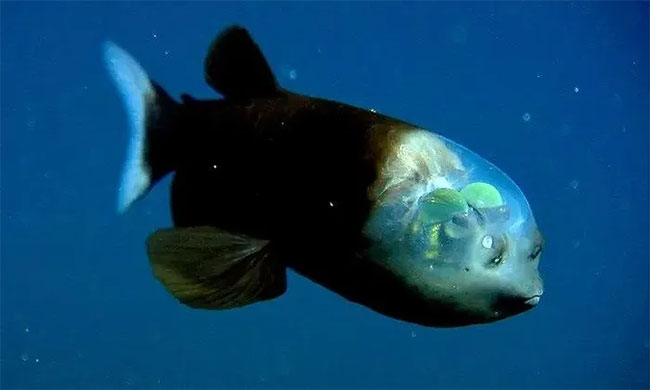Discovering super rare fish in the sea
These are giant spherical lenses that sit on a pair of long silver eye tubes. They are male fish (Macropinna microstoma).
The green tint (which actually comes from a yellow pigment) acts as a kind of sunglasses, helping them track their prey.
Under the ocean with nowhere to hide, many animals that live here have glowing bellies to camouflage contrast and protect themselves. Because bioluminescent prey is difficult to detect when the faint blue light of the sun shines down. But the sperm whale is one step faster.

The male fish has light-sensitive eyes that can be rotated in a transparent shielding dome. The two spots on the mouth are similar to human nostrils.
Bruce Robison, a deep-sea biologist at the Monterey Bay Aquarium Research Institute in California, says the eye pigment of male fish allows them to distinguish between sunlight and bioluminescence. It helps the species to clearly see animals trying to hide their shadows in the water.
The tubular eyes of the male fish are very sensitive and absorb a lot of light, so they are favorable in dark areas like the sea level.
After years of observing dead and trapped fish, Mr. Bruce's team has learned more about these species, through a specialized camera that can be controlled remotely.
"Suddenly a light bulb came on and I suddenly understood the problem. They could turn their eyes," he said. This means that the male fish can track prey as it drifts underwater until it's right in front of their mouth.
Watching a male fish swim in the deep sea, Mr. Bruce also discovered something that other scientists had previously overlooked.
"They have a dome that shields their eyes like the head of a jet," he said, pointing to the transparent part of their backs, which had been ripped out of the specimens he had brought from the sea.
This canopy helps to protect the male's eyes as they rob food from the stinging tentacles of siphonophores - transparent, dangerously long filaments that drift in deep water.
A mixture of food has been found in the stomachs of male fish, including the tentacles of siphonophores, and small crustaceans that feed on siphonophores such as saber-claws.
The male fish's hunting strategy is to swim to the siphonophores, and nibble on small prey trapped in the siphonophore's tentacles, using a transparent shield to protect the turquoise eyes from being bitten.
However, finding drumheads in the wild is not easy.
In his 30-year career, Mr. Bruce has only seen this 15-cm-long fish alive about eight times. "We spend a lot of time exploring under the sea, so I can say with confidence that they are quite rare," he said.
- Discovering fish with legs in Cao Bang
- Top 10 rare and expensive fishes in Vietnam
- Looking at species of sea fish,
- Discovered a lot of particularly hardy toad fish in Phu Tho
- 8kg fish weighed suspicion of fish and gold and silver billions of fishermen
- Catching the near-extinct fish worth nearly 10 billion
- Protecting rare and precious fish species in flipping Binh Thien
- Finding rare orange tail toad fish in Nghe An
- Discovering super-rare and precious Yunzhi mushrooms in China
- Catch 3 rare moon fish in the same day
- Rare fish caught in the central fishing net
- Artificial reproduction of the spotted fish, spotted fish
 Surprised: Fish that live in the dark ocean still see colors
Surprised: Fish that live in the dark ocean still see colors Japan suddenly caught the creature that caused the earthquake in the legend
Japan suddenly caught the creature that caused the earthquake in the legend A series of gray whale carcasses washed ashore on California's coast
A series of gray whale carcasses washed ashore on California's coast Compare the size of shark species in the world
Compare the size of shark species in the world Strange species in Southeast Asia becomes the first marine fish species 'extinct due to humans'
Strange species in Southeast Asia becomes the first marine fish species 'extinct due to humans'  What time of day is the easiest to fish?
What time of day is the easiest to fish?  Special uses of a highly poisonous plant that grows throughout Vietnam
Special uses of a highly poisonous plant that grows throughout Vietnam  Why are there so many giant fish flooding the Three Gorges Dam but no one dares to catch them?
Why are there so many giant fish flooding the Three Gorges Dam but no one dares to catch them?  Specialty fish 'vong bat lieu ngu' is more expensive than gold but still sought after
Specialty fish 'vong bat lieu ngu' is more expensive than gold but still sought after  Hundreds of fish jumped out of the lake in China, what happened?
Hundreds of fish jumped out of the lake in China, what happened? 